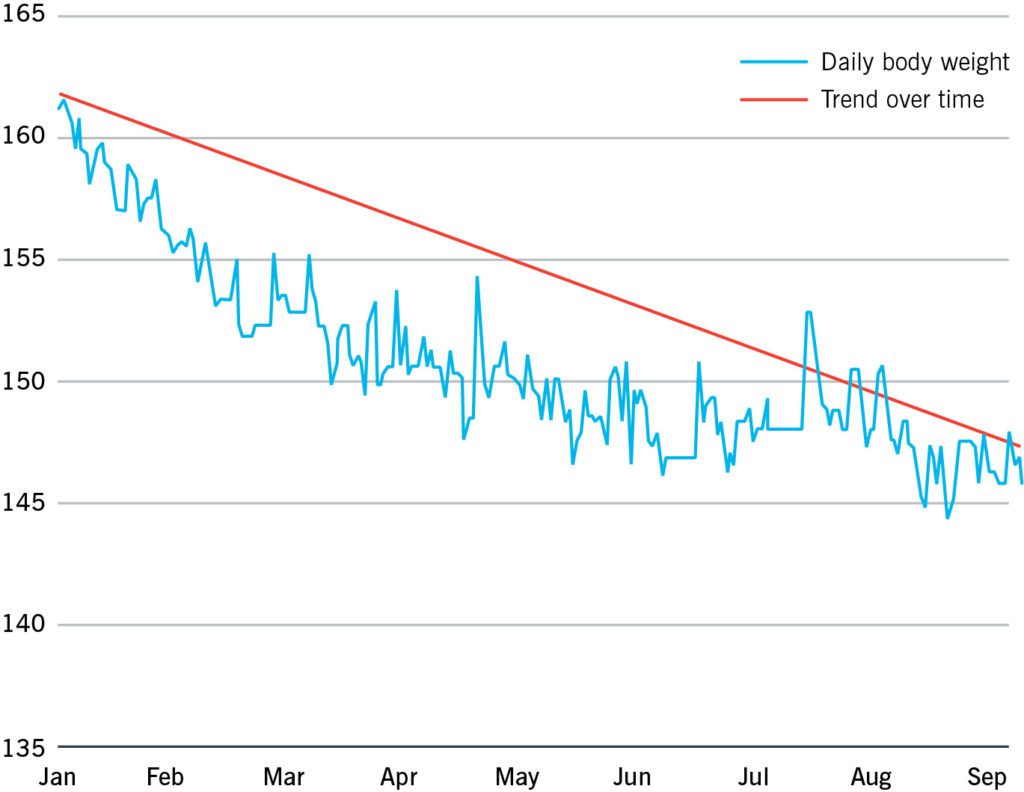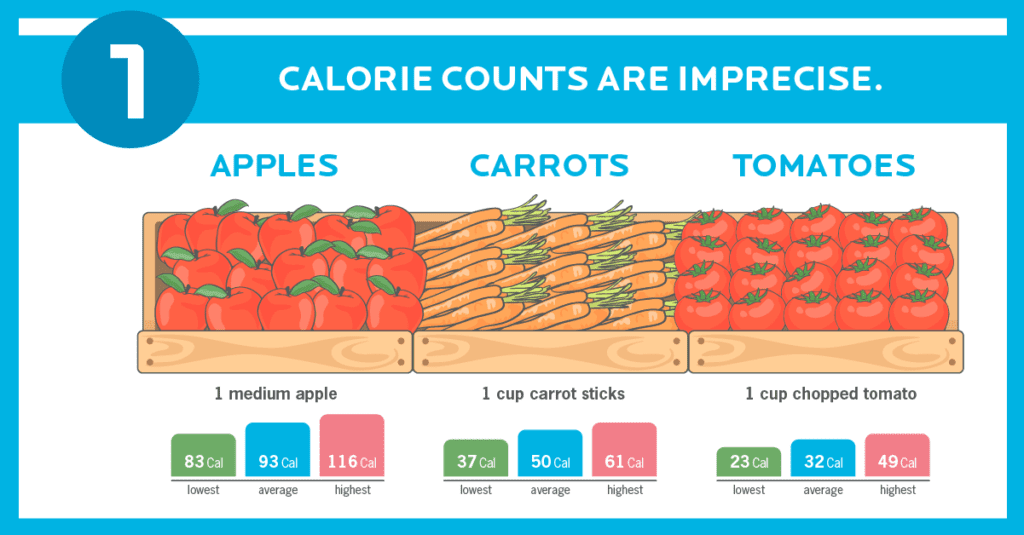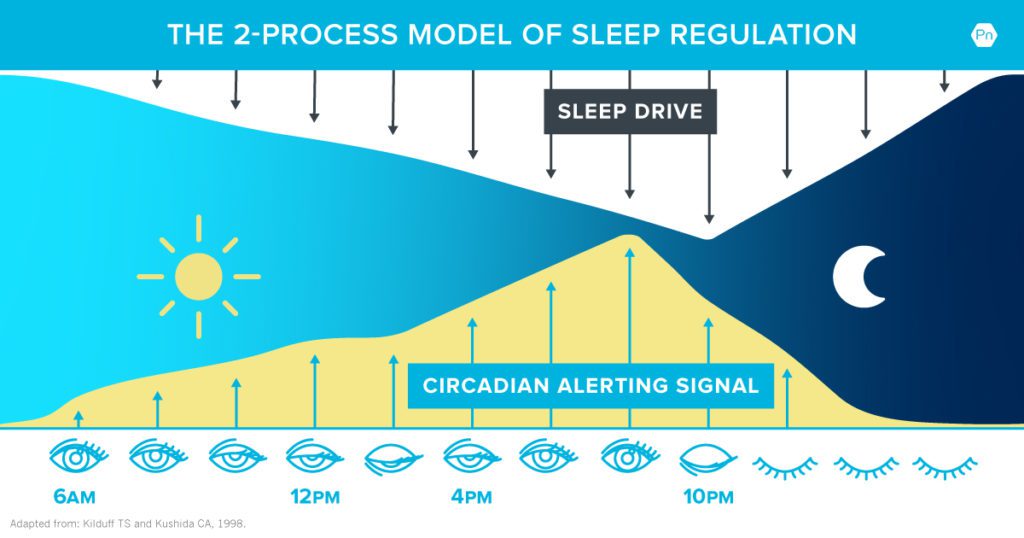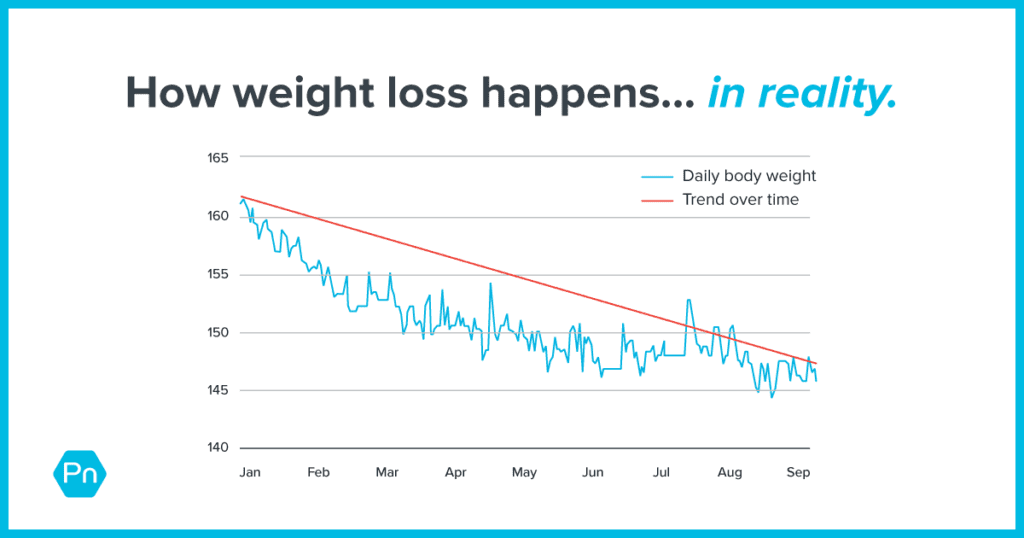Every day, Lina wore a ring that continually monitored her heart rate, sleep quality, and activity levels. Most evenings, she excitedly examined its data.
“It’s amazing. It changed my life,” she told anyone who asked. “You should totally get one!”
Jeron? He was a different story.
He, too, used a device to track his sleep. But the more his smartwatch revealed, the more he tossed and turned.
Lina and Jeron are among many people who use devices to track weight, body fat, running speed, steps, calories burned, calories consumed, heart rate, body temperature, respiratory rate, brain waves, and more.
Thanks to modern technology, we can know more about ourselves (and our clients) than ever before.
But does everyone benefit from so much information?
Who will respond as Lina did? And who will respond like Jeron?
In this article, you’ll find answers to those questions, as well as:
- The pros and cons of high-tech trackers
- 10 low-tech tools capable of tracking client progress just as effectively as the smartest gadget
- Easy checklists that help you match clients with the best data-tracking methods for them
- Strategies for helping clients see data in a healthy way
Data and gadgets are cool. But depending on context and perspective, they have the potential to help or hurt a person’s health efforts.
Here’s how to know what’s right for you (or your clients).
++++
Data points help people understand how they’re doing.
Let’s say someone wants to improve their health. To reach that goal, they might decide to replace their nightly ice cream with a piece of fruit.
To see if that change is working, they could measure:
- a behavior, such as how often they’re doing the action. For instance, they might track how often they ate fruit instead of ice cream after dinner.
- an outcome, such as their cholesterol level or blood pressure. Outcomes can either be objective (like bloodwork) or subjective, such as someone’s stress or energy level.
Either way, the information is a progress indicator, helping assess whether a change is actually working.
But is tracking progress always a good thing?
5 surprising truths about data tracking
Truth #1: Different types of people thrive on different types of data.
Some people respond great to data.
Other people, however, can become anxious.
Rather than seeing their weight, heart rate variability, or sleep quality as a way to judge the effectiveness of what they do, some folks view these metrics as a statement of who they are.
When someone takes data personally, they might step on the scale and feel hopeless, thinking, “What’s wrong with me?”
Or they’ll look at a sleep-tracker and think, “My sleep sucks—I must be broken!”
A PhD candidate at Colorado State University, Kayla Nuss, MA, MS, PN1, has focused much of her graduate research on the relationship between data trackers and motivation to exercise.
Based on her findings as well as research by others,1,2 she says people are more likely to take data personally if they:
✓ See the behavior they’ll track as a chore, making comments like, “I have to do this to lose weight.”
✓ Don’t feel they have a choice. Someone might say, “I don’t want to exercise, but my doctor told me I have to.”
✓ Do the behavior to avoid feeling guilty. In other words, they exercise because they don’t want to feel bad about not exercising.
(You’ll learn more on how to help people see data differently a little later.)
Truth #2: A measurement is only useful if it helps you make a decision.
For many people, wearable devices offer a fun diversion and satisfy curiosity.
Without an action plan, though, devices are interesting, but not helpful.3
Consider the difference between:
- Someone who tracks their mile splits to see if their new training plan is improving their running speed.
- Someone who tracks their mile splits because their watch does it automatically (so why not?).
The first person will eventually be able to make a decision: Keep following the same training plan—or talk to their coach about making an adjustment.
The second person has only a bunch of numbers—and possibly some frustration. They may even become overtrained if they continually push themselves to beat their mile splits, without following a training plan that ensures adequate recovery.
Truth #3: Some trackers spit out inaccurate data.
The reliability of a tracker, research says, depends on a number of factors: the part of the body it monitors (finger, wrist, arm, chest), the tracker’s algorithm, the sensors used, and the activity being monitored.4,5
The least accurate progress indicators include:
Distance: Though technology has improved in recent years, some trackers overestimate your distance when you move at faster speeds, and underestimate your distance at slower speeds.
Trackers with GPS technology are usually more accurate than ones without it, though dense tree foliage and tall buildings can interfere with GPS signals.6-8
Sleep quality: Sleep trackers tend to overestimate hours slept and sleep efficiency, and underestimate the number of waking moments.9,4
Calories consumed: Generally speaking, calories are tough to measure, regardless of the tool. As a result, the calories listed on menus and food labels can be off by as much as 20 percent.10 (And that’s not the only thing that throws off calorie counts, as we detail in this infographic: The surprising problem with calorie counting.)
Calories burned: Trackers that estimate your calorie burn often do so based on laboratory averages, with large margins of error (around 10 to 23 percent).11,4 (Read more: The problem with tracking calories burned.)
![]()
Now, if someone’s using a tracker merely to get a sense of a general trend or pattern, this lack of accuracy may not matter so much. But if they’re basing important decisions on these readouts? Problems develop.
Let’s say someone’s watch reports that they burned 400 total calories during a run. So they think, “Yay! I ran hard. Now I can eat 400 extra calories.”
Not so fast.
First, they might think they are eating 400 calories, but really consume as many as 480, thanks to that wishy-washy calorie math.
Second, also due to wide error margins, they may have really burned as few as 320 calories.
Finally, the numbers shown on the device aren’t all extra calories burned by the activity itself.
Anytime you see “calories burned,” it also includes the number of calories you use through normal, resting metabolism—and would have burned whether you ran or sat completely still. (For a 180-pound person, for instance, that resting metabolic rate is about 1.2 calories per minute.)
End result: They can easily end up eating 160-plus calories beyond what they expended.
Truth #4: High-tech trackers do motivate some people—for about three months.
When many people get a new smart device, they become absolutely obsessed. They wear it all the time. They study their data. They try to beat their step, mile, or speed counts.
It all works like magic.
Until it doesn’t.
“We humans get bored super quickly. We buy a fancy gadget thinking it will solve all our problems, and use it every single day for a few weeks or months,” says Kate Solovieva, MA, Pn2, a Precision Nutrition master coach.
“But then we take it off that one time in the shower. Or the battery dies, and the charger is in the other room, so we toss the gadget in our underwear drawer. For now. Two years later, we’re looking for a charger for our NEW fancy gadget, and find the old one in the drawer, and think… ‘Oh yeah!’”
Researchers call this the novelty factor.12,13 By the end of a year, only about 10 percent of people are still using their trackers, one study found.14
Truth #5: High-tech trackers can demotivate some people.
This is especially true of trackers that come with preset goals, such as sleeping a certain number of hours or walking a certain number of steps a day.15
When someone continually falls short of the goals the tracker sets, they can feel discouraged. Not only do they stop using the tracker, but they may also give up trying to improve the activity they were tracking, says Nuss.
“For some people, the tracker is the right tool. For others, it’ll lead to a persistent feeling of, ‘Geez, I suck.’”
How to know if data tracking will help your client
When it comes to data, there are basically three types of people:
- People who benefit from a lot of data
- People who benefit from some data—but who don’t need a heck of a lot of it
- People who can be harmed by an overemphasis on data
Here’s how to figure out which category a client falls into.
People who benefit from a lot of data tend to:
✓ Be numbers-oriented. These clients often have engineering, actuarial, or accounting mindsets.
✓ Have more advanced goals. This includes elite athletes, bodybuilders, models, and other people who get paid based on how they look or perform. For them, a slight variance is the difference between placing first or 10th.
✓ See data as information—nothing more. Regardless of their profession, the numbers don’t define them. They aren’t part of their identity. For them, data can be helpful—because they can view it as just that.
People who benefit from some data tend to:
✓ Have simple goals. They want to look or feel better, to get in shape, or feel more energetic, among other things. And, while some data definitely will help them to progress, they don’t need a ton of it.
✓ Don’t get overly wrapped up in the numbers. An unexpected occurrence (like sudden weight gain) could bum them out, for sure. But with a little coaching, they’re able to turn their focus away from “That sucks” and over to, “Okay, that’s interesting. What should I try next?”
People who can be harmed by an overemphasis on data tend to:
✓ Have an unhealthy obsession with food and/or fitness. These clients can become so fixated on the numbers that they can’t think of anything else.
✓ Have unclear core values. When clients don’t define how a goal aligns with their deeper values, they never feel good enough—no matter what the numbers say. Think: The person who always wants to lose five pounds, no matter what they weigh.
✓ Have inaccurate or miscalibrated standards. Many recreational exercisers, for instance, beat themselves up for not having elite performances. They don’t have a realistic sense of what to expect.
✓ Be anxious about the activity they plan to track. Rather than feeling motivated by a sleep tracker, they might toss and turn even more.16
✓ Have perfectionistic thought patterns, aka “not-good-enough-itis.” When talking about a measurement, they insert themselves into the story. Failing to meet a timed workout goal quickly becomes “I’m slow” or “I suck” rather than “I’ll get it next time.”
✓ Be so competitive that they get injured or overtrained. Rather than take an off or easy day, they might try to get in more steps, beat their previous personal best walking time, or destroy the competition during the Workout of the Day.
Help clients use data effectively.
It’d be great if all clients saw measurements merely as a way to test the effectiveness of their action plan. But that’s not how a lot of people start out.
Here’s how to help clients view data as feedback.
Define progress.
Add specificity to hazy goals like “lose fat” and “get strong.”
Lose fat might become “get my body fat percentage below 25 percent.” And “get strong” might become “be able to get up off the floor while holding one of my grandchildren.”
Also, tie those specifics to a deeper value by asking, “Why?” over and over. (See our 5 Whys worksheet for specifics.)
The conversation might go like this:
Coach: That’s great that you want to get stronger. Could you tell me a little more about that? Why is that a goal for you?
Client: Well, I used to feel strong and now I don’t. I want to feel like I used to.
Coach: Great answer! Let’s dig even deeper. Why do you want to feel like you used to feel?
Client: Well, it kind of sucks being this weak. I used to be able to do things easily. Take groceries. It wasn’t always hard for me to carry the bags into the house. Now it is.
Coach: That’s really insightful. Why do you want those activities to feel easier?
Client: By the time I’m done with my shopping and errands, I’m so exhausted I can barely stand up, let alone hang out with my grandkids. I don’t want to be the grandma who can’t do anything. I want to be right there with them.
Coach: Bingo! Keep that strong grandma image front of mind. It’ll help keep you motivated. Now, let’s take a look at some ways to measure your progress.
Talk about how you’ll measure progress.
Nutrition coaches work with clients to create an initial action plan, based on what the client needs to do to get to where the client wants to go.
Then they break that plan down into one small, specific action to try—say eating one extra serving of veggies a day—and come up with a way to test it.
The test might track behavior, looking at how consistently the client ate an extra serving of veggies. Or the test might track an outcome, perhaps how energetic the client feels each day.
Either way, it’s testing the action—and not the person doing the action.
To explain all this for a client interested in fat loss, you might say:
Coach: I know your goal is fat loss, but I’m not too concerned with whether you’re losing weight right now. For the first several weeks, we’re going to work on a few foundational skills that’ll help make changing how you eat feel a lot easier. It’s similar to investing now for a big payoff later.
Client: So…. I don’t need to weigh myself right now?
Coach: Actually, if you’re comfortable with it, it’d be great if you would. Tracking your weight will help us to get a better idea of your true baseline. Does that sound okay to you?
Client: Yeah, I think so. But I really want to lose weight now.
Coach: I get it. It’s really hard to wait, but it’ll be worth it. Scale weight can fluctuate a lot, so it helps to look at the trend over time opposed to just one point in time. Just know that if the trend isn’t moving downward over time, we’ll work together to determine the reason and then tweak the original plan.
Client: Yep. I can give that a try.
Coach: That’s great. And if you can’t, that’s okay. If this brings up negativity for you, we can switch to a different tracking method. Okay?
Client: Yup. Got it.
Focus on patterns.
No one improves in a consistent linear fashion. Usually, it’s a two steps forward, one step back process. An athlete might crush every single workout one week, lag the following week, only to return week three to hit another personal best.
See the chart below for a visual for someone interested in fat loss.

The following conversation shows how you might help drive this home.
Client: Ugh, my weight is all over the place! I gained 4 pounds in one day. How is that even possible? This is stressing me out.
Coach: I hear that. It’s actually totally normal for your weight to vary from day to day. My weight has gone up by as much as 5 pounds in 24 hours based on my hydration status alone. So let’s not worry about a number from just one day. Let’s pay attention to the overall trend.
Client: How does that work?
Coach: Well, we want to look at patterns—and use those patterns to make decisions. For example, when one of my clients stopped eating dinner in the dining room and instead started eating in front of the TV, their weight trended up over time.
Another client struggled to sleep at night whenever they drank two cups of coffee instead of just one. In other words, we’re not looking at just one occurrence. We’re looking for a trend. Does that make sense?
Client: Yep, got it. That thing you said about coffee? Totally me.
Alternative ways to track progress
It’s easier for clients to see patterns when they write things down.
By filling out a worksheet before trying a new behavior and again after practicing that behavior, they’ll be able to feel good about everything they’ve done right.
These templates can help.
Consider using a different tracking method.
If a client becomes more anxious despite your efforts to help them see measurements as feedback, it’s time to make some changes.
You might:
Ask your client to collect data, but not look at it. For example, some smart scales can be programmed to send data to the coach, but not display a weight to the client.
Run an experiment. Suggest your client part ways with an anxiety-producing tracking method for two weeks. During their break, they might track differently (or not at all).
Instead of using a sleep tracker, for example, they might track an energy rating, and sleep quality. Or, rather than trying to hit a specific heart rate during a workout, they could use Rate of Perceived Exertion (RPE).
After two weeks, reassess. Did their anxiety go down?
Empower your client. You, as the coach, don’t have to know all the answers. So rather than immediately suggesting a different tracking method, you could put it back on your client. You might ask any of the following:
| “I’m hearing that the scale is bringing up a lot of anxiety for you. Totally understand. I’d love to explore this a little further if you don’t mind. What other methods might we use to measure how you are doing? What do you think will work?” |
| “From the outside, it doesn’t seem like this tracking method is working for you. Would you agree? Is there another way of tracking your progress that you think might work better?” |
| “So your workout performance is trending down. And it sounds like you feel personally attacked by the numbers. That’s okay. It’s quite normal actually. But I’m curious how you feel about leaning into the opposite. What’s good about finding out this information? Is there a way you can use this data to your advantage?” |
Don’t make it about you.
As much as possible, try to resist any urge to convert clients to your personal tracking solution.
Sure, your favorite tracking method might work great—for you.
And it might even help many of your clients.
But there will always be someone who doesn’t fit the mold.
“As a coach, always consider that the opposite of your experience is possible,” says Solovieva.
“If a smart tracker is the best thing that ever happened to you, be open to the idea that it could be harmful to someone else. And if trackers send you to a dark place, understand that they could actually work really well for some of your clients.”
In other words, know your personal bias, keep an open mind, listen deeply, and encourage clients to be a part of the decision-making process.
That way you’ll help clients discover the best tracking method for them—whether that entails lots of data or hardly any at all.
References
Click here to view the information sources referenced in this article.
If you’re a coach, or you want to be…
You can help people build sustainable nutrition and lifestyle habits that will significantly improve their physical and mental health—while you make a great living doing what you love. We'll show you how.
If you’d like to learn more, consider the PN Level 1 Nutrition Coaching Certification. (You can enroll now at a big discount.)





Share